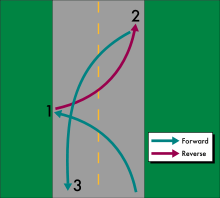Three-point turn

The three-point turn (sometimes called a Y-turn, K-turn, or broken U-turn) is the standard method of turning a vehicle around to face the opposite direction in a limited space, using forward and reverse gears. This is typically done when the road is too narrow for a U-turn.
Demonstrating this manoeuvre is commonly required in a driving test.
Process
The basic manoeuvre consists of driving across the road turning towards the offside kerb, reversing across the road to the original nearside kerb while turning, and driving forward towards the original offside kerb, now the nearside.[1] In a narrow road or with a longer vehicle, more than three legs may be required to achieve a full 180 degree rotation.
Naming
"Three point turn" is the formal name in Australia, Canada, New Zealand, and in many regions of the United States.[2][1][3][4][5][6] Less common terms are: "Y-turn",[7] "K-turn",[8] and Broken U-turn[9] but in the UK and Ireland, the official name is "Turning in the road (using forward and reverse gears)"[10] - because an acceptable turn may include more than three points.[11]
Notes
- 1 2 MTO 2009.
- ↑ vicroads 2012.
- ↑ NZTA Road Code: http://www.nzta.govt.nz/resources/roadcode/driving-skill-syllabus/lesson-18.html
- ↑ New York State Department of Motor Vehicles. "Driver's Manual - Chapter 5". October 2011. Retrieved on 20 July 2013.
- ↑ Arizona Department of Transportation. "Non-Commercial Driver License Examiner Manual". 1 April 2010, pp. 22-24. Retrieved on 20 July 2013.
- ↑ North Carolina Department of Transportation. "North Carolina Driver's Handbook". January 2012, p. 9. Retrieved on 20 July 2013.
- ↑ wiscroads 2012.
- ↑ Moore, Greg. "School district sued over fatal crash" (News release). Idaho Transportation Department, 5 October 2011. Retrieved on 20 July 2013.
- ↑ Mallozzi, Vincent M. "Now, Don't Hit That Cone". New York Times, 11 September 2005. Retrieved on 20 July 2013.
- ↑ "Driving and transport: Teaching people to drive", www.gov.uk/
- ↑ DfT 1991, p. 212.
References
- Department for Transport (1991). Driving. HMSO. ISBN 978-0-11-550355-9.
- Ministry of Transportation of Ontario (2009). "Three-Point Turn". The Official MTO Driver's Handbook.
- "Vicroads, How your driving is assessed".
- "Wisconsin Department of Transportation, Class D road test study guide".
Further reading
- Driving Standards Agency (2010). "Turning in the Road". The official DSA guide to driving: the essential skills (7th ed.). The Stationery Office. pp. 192–193. ISBN 978-0-11-553134-7.